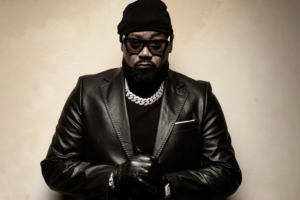Ghostface Killah, one of the most dynamic and innovative voices in hip-hop, has carved a niche as a lyrical storyteller with a cinematic approach. Known for his unique delivery and rich narratives, Ghostface has consistently captivated audiences, both as a solo artist and a member of the legendary Wu-Tang Clan. From his early days in Staten Island’s Stapleton projects to his current standing as a hip-hop icon, his journey is one of resilience, creativity, and reinvention.
Laying the Foundation: Early Life and Struggles

Born Dennis Coles in 1970, Ghostface Killah grew up in the Stapleton Housing Projects of Staten Island, New York. Raised by a single mother, his childhood was marked by financial struggles and the responsibility of caring for two siblings with muscular dystrophy. Despite these challenges, his environment shaped his gritty yet reflective perspective, which later became central to his music.
At just 15 years old, Ghostface faced his first stint in prison. However, his formative years also introduced him to Robert Diggs, better known as RZA, a future mentor and collaborator. Their bond, forged in the mid-1980s, became the cornerstone of an ambitious project that would redefine hip-hop forever.
The Birth of a Clan: Wu-Tang’s Meteoric Rise
By the early 1990s, Ghostface was among the founding members of the Wu-Tang Clan, a collective led by RZA that brought together nine distinct voices. Alongside Raekwon, Method Man, Inspectah Deck, Ol’ Dirty Bastard, GZA, U-God, Masta Killa, and RZA himself, Ghostface contributed to the group’s groundbreaking debut album, Enter the Wu-Tang (36 Chambers).
Released in 1993, the album’s raw energy and unfiltered lyricism captured the zeitgeist, revolutionizing the hip-hop genre. Ghostface made his mark with a standout verse on the opening track, showcasing his vivid storytelling and unhinged delivery. Reflecting on that era, he recalls the electrifying energy within the studio: “I knew my brothers were destined for greatness even before the music dropped,” he said. “The way Deck, Rae, Meth, and GZA were spitting was otherworldly.”
Ghostface Killah’s Unique Voice
What set Ghostface apart from his Wu-Tang counterparts was his unparalleled ability to craft vivid, cinematic narratives. His lyricism painted pictures of street life, personal struggles, and fantastical tales, delivered with an intensity that demanded attention. Fans were drawn to his authenticity and his knack for blending the surreal with the deeply personal.
Life Beyond the Studio: Trials and Growth
While the Wu-Tang Clan soared, Ghostface faced his demons. His early years in the industry were tumultuous, with reports of excessive partying and confrontations. He openly admits to battling substance abuse and recklessness, which earned him a reputation as a volatile figure.
Yet, through these struggles, Ghostface found solace in spirituality. He embraced the teachings of the Five Percent Nation, an offshoot of the Nation of Islam, which he credits for his transformation. “Spirituality has always been there, but over time, I’ve grown more grounded and humble,” he reflects. This newfound clarity influenced his music and approach to life.
A Solo Legacy: Ghostface as Tony Starks
Ghostface Killah’s solo career began in 1996 with Ironman, a critically acclaimed album that showcased his versatility and emotional depth. Adopting the moniker “Tony Starks,” inspired by Marvel Comics’ Iron Man, he leaned into his storytelling roots with a mafioso twist.
Over the years, Ghostface expanded his discography with projects like Supreme Clientele (2000) and Fishscale (2006), cementing his status as one of the most consistent and innovative solo artists in hip-hop. His music often blended vivid tales of street life with soulful samples, reflecting his love for 70s soul and funk, a genre he grew up hearing through his mother’s record collection.
The Conceptual Genius: Twelve Reasons to Die
In 2013, Ghostface teamed up with producer Adrian Younge for the conceptual masterpiece Twelve Reasons to Die. The album, a dark and theatrical narrative, tells the story of Tony Starks, a mob enforcer in 1960s Italy. Betrayed by the mafia and murdered, Starks’ ashes are pressed into vinyl records, which, when played, bring him back as the vengeful Ghostface Killah.
Ghostface credits Younge for pushing him creatively: “Adrian is like a scientist. He doesn’t record digitally—it’s all reel-to-reel, old-school style, which gives the music this raw, authentic feel.” The album’s cinematic quality, reminiscent of classic crime films, resonated deeply with fans and critics alike.
Mafia and Martial Arts: Wu-Tang’s Cultural Influences

The Wu-Tang Clan’s aesthetic has always drawn heavily from organized crime lore and martial arts cinema. For Ghostface, crime movies like The Godfather and Scarface offered lessons in loyalty and strategy, themes he wove into his lyrics. He admired the hitmen in these films, who operated with precision and purpose amidst chaos.
Kung-fu flicks, another staple of Wu-Tang’s identity, further enriched their storytelling. These films provided metaphors for discipline, resilience, and honor—qualities Ghostface integrated into his artistry.
Evolving Soundscapes and Timeless Themes
Ghostface’s music has continually evolved, but one constant is his love for soul music. He has long admired The Delfonics, a group whose melodies influenced his style. Ghostface collaborated with Younge on a parallel project featuring Delfonics singer William Hart, celebrating the soulful sounds that shaped his upbringing.
His passion for authentic, analog production aligns with his belief in storytelling that feels genuine. “Music should sound raw and emotional, not too polished,” he insists. “It’s about capturing a vibe.”
Spirituality and Reflection: A New Ghostface
As Ghostface matured, so did his perspective on life and success. Now more introspective, he uses his platform to inspire others while staying true to his roots. His spirituality continues to guide him, providing a sense of purpose beyond fame.
Legacy in Hip-Hop
Ghostface Killah’s contributions to hip-hop extend far beyond his discography. As a founding member of Wu-Tang Clan and a prolific solo artist, he has influenced countless artists with his lyrical ingenuity and fearless storytelling. His ability to adapt while maintaining authenticity ensures his relevance in an ever-changing music landscape.
The Future: Ghostface’s Vision
Today, Ghostface remains as active as ever. Whether collaborating with new artists or exploring creative ventures, he is a testament to longevity in the music industry. His story serves as an inspiration—a reminder that greatness often stems from resilience, creativity, and an unwavering commitment to one’s craft.
As he continues to evolve, one thing is certain: Ghostface Killah always has a story to tell storysecond.com.







